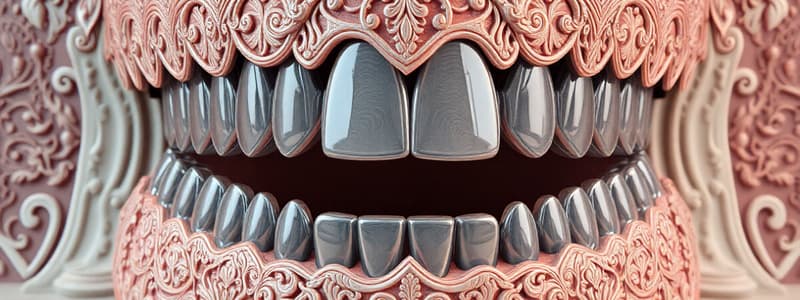Podcast
Questions and Answers
What is the primary function of occlusion blocks in denture fabrication?
What is the primary function of occlusion blocks in denture fabrication?
- To minimize the weight of the denture
- To help in tooth selection and maintain vertical dimension (correct)
- To adjust the color of the denture
- To increase the size of the denture base
Which of the following is NOT a requirement for a trial denture base?
Which of the following is NOT a requirement for a trial denture base?
- Inconsistent thickness (correct)
- Dimensional stability with minimal warpage
- Accurately adapted extensions
- Rigid construction
What is the purpose of waxing out tissue undercuts on master casts?
What is the purpose of waxing out tissue undercuts on master casts?
- To protect the casts from damage (correct)
- To improve the aesthetics of the denture
- To increase the size of the denture base
- To adhere the denture to the gum
How long should the master cast be soaked in water before making the record base?
How long should the master cast be soaked in water before making the record base?
What is applied as a separating medium to protect the cast during record base fabrication?
What is applied as a separating medium to protect the cast during record base fabrication?
What is a critical requirement related to the thickness of the record base?
What is a critical requirement related to the thickness of the record base?
What should be the thickness of the record base on the crest of the ridges?
What should be the thickness of the record base on the crest of the ridges?
What is the main reason for applying the tinfoil substitute in two thin layers?
What is the main reason for applying the tinfoil substitute in two thin layers?
Which of the following areas on the mandibular cast may require block out for undercuts?
Which of the following areas on the mandibular cast may require block out for undercuts?
What is NOT a use of the occlusion rim?
What is NOT a use of the occlusion rim?
What is the general width of occlusion rims in the posterior region?
What is the general width of occlusion rims in the posterior region?
Where is the labial surface of the maxillary occlusion rim positioned relative to the incisive papilla?
Where is the labial surface of the maxillary occlusion rim positioned relative to the incisive papilla?
What is the vertical height of the mandibular occlusion rim?
What is the vertical height of the mandibular occlusion rim?
What misconception should patients be informed about regarding record bases and occlusion rims?
What misconception should patients be informed about regarding record bases and occlusion rims?
What is determined using the occlusion rim during the arrangement of teeth?
What is determined using the occlusion rim during the arrangement of teeth?
What is the height of the posterior lower region of the mandibular occlusion rim relative to the retromolar pad?
What is the height of the posterior lower region of the mandibular occlusion rim relative to the retromolar pad?
Flashcards
Record Base
Record Base
A temporary, rigid base made of acrylic resin, accurately fitted to a dental cast, used in creating complete dentures.
Occlusion Blocks
Occlusion Blocks
Components attached to trial denture bases, used to establish facial contours, tooth selection, and occlusion.
Trial Denture Base Requirements
Trial Denture Base Requirements
Characteristics a trial denture base must possess: rigidity, precise fit, dimensional stability, undercut relief, smooth surface, consistent thickness and ease of construction.
Wax Block-out
Wax Block-out
Signup and view all the flashcards
Casting Soaking
Casting Soaking
Signup and view all the flashcards
Tinfoil Substitute
Tinfoil Substitute
Signup and view all the flashcards
Acrylic Resin
Acrylic Resin
Signup and view all the flashcards
Two-layer Application
Two-layer Application
Signup and view all the flashcards
Record base dimensions
Record base dimensions
Signup and view all the flashcards
Occlusion rim material
Occlusion rim material
Signup and view all the flashcards
Occlusion rim uses
Occlusion rim uses
Signup and view all the flashcards
Posterior occlusal rim width
Posterior occlusal rim width
Signup and view all the flashcards
Anterior occlusal rim width
Anterior occlusal rim width
Signup and view all the flashcards
Maxillary occlusal rim labial height
Maxillary occlusal rim labial height
Signup and view all the flashcards
Mandibular occlusal rim vertical height
Mandibular occlusal rim vertical height
Signup and view all the flashcards
Patient Communication about record bases
Patient Communication about record bases
Signup and view all the flashcards
Study Notes
Record Base and Occlusion Blocks
- Occlusion blocks are composed of occlusion rims attached to well-fitting trial denture bases.
- The record base and occlusion rims are essential for establishing facial contours.
- They assist in tooth selection and maintaining the vertical dimension of occlusion during record-making.
- Interocclusal records are created using these components.
- The denture teeth' arrangement is also facilitated by record base and occlusion rims
- The external surface of the complete denture's waxed-up mold is also produced using these elements.
Requirements of a Trial Denture Base
- A trial denture base should be rigid.
- It needs to fit the cast accurately and have proper extensions.
- It should maintain dimensional stability with minimal warpage during use.
- Undercuts must be relieved to avoid damaging the cast during placement and removal.
- The base should be smooth and clean to ensure patient comfort.
- A uniform thickness of 2mm is desirable.
- The base needs to be easy to construct.
Wax Block Out
- Wax block out protects the master casts from tissue undercuts and irregularities.
- Base plate wax is used to block out undercuts and/or irregularities.
- The labial surface of the anterior ridge, Rugae areas and sometimes the tuberosity areas laterally are areas of concern.
- On the mandibular cast, the retromylohyoid areas may need a wax block out.
Soaking the Master Cast
- The master cast is soaked in room-temperature water for 5 minutes.
- This step expels air from within the stone; minimizing bubble-like defects in the completed record base.
Tinfoil Substitute
- A tinfoil substitute is employed as a separating medium to protect the cast and enable the record base's separation.
- The tinfoil substitute is applied twice, allowing the first layer to dry before applying the second.
- Each layer is applied as a thin film covering all surfaces of the cast, including land areas and any parts that could come into contact with the resin.
Record Base Fabrication
- The record base is created using autopolymerizing acrylic resin.
- The tinfoil substitute method is used to create the record base by applying it in two thin layers.
Record Base Dimensions
- The record base should be thinner on the crest of the ridges and buccal to the crest of ridges.
- The base should not block off spaces that denture teeth might need later on.
Occlusion Rim Fabrication and Uses
- Occlusion rims are typically created using pink modeling wax.
- Occlusion rims are vital for jaw relationship registration.
- The rims aid in selecting the proper artificial teeth as they can assist with determining the midline, high and low lip lines, canine lines, and canine line to posterior teeth distance.
- They aid in tooth arrangement preparation
- Occlusion rims provide support for lips and cheeks
Occlusion Rim Dimensions
-
Posterior rims are roughly 8-10mm in width.
-
Anterior rims are roughly 6-8mm in width.
-
A 22mm vertical height is usually needed for the mandibular occlusion rim.
-
The posterior area's height corresponds to two-thirds the height of the retromolar pad.
-
The labial surface of the maxillary occlusion rim in the central area is roughly 6-8 mm anterior to the middle of incisive papilla and is labially inclined.
-
The record rim and base should not be a part of the finalized dentures.
-
Inform patients that they will feel slightly loose due to the blocked-out undercuts.
Posterior Palatal Seal (PPS)
- The posterior palatal seal area must be prepared.
- The varying degrees of compressibility of the tissues (up to 1mm) are marked out accordingly.
- The vibrating line establishes the posterior boundary of the PPS
- This is defined with a #6 round bur in a depth of 0.5–1mm.
- Other regions require smoothening by using Cleoid-Discoid instruments.
- The anterior border of the PPS requires feathering.
Studying That Suits You
Use AI to generate personalized quizzes and flashcards to suit your learning preferences.




